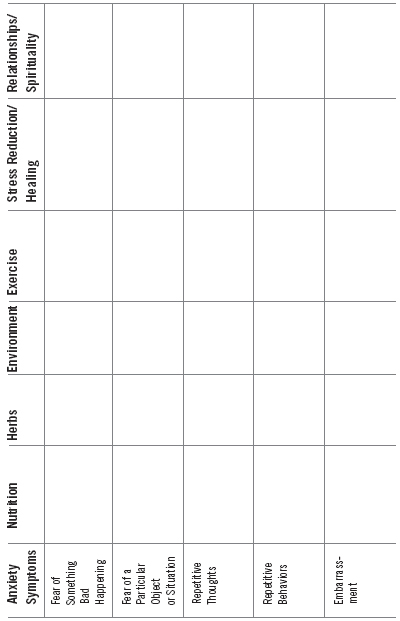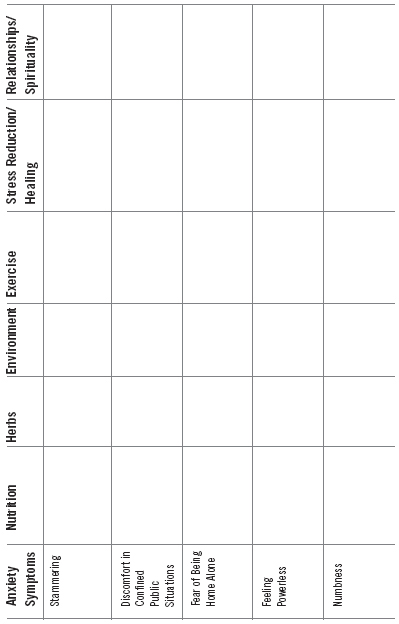Now that you have read this far, you have all the information you need to put together your personal anxiety success plan. One thing to always keep in mind is that anxiety, like other emotions, is often created by your attitude. If you enter a situation with the attitude that you aren’t competent and don’t have the skills you need, you’ve already defeated yourself. Staying positive is crucial to success. A negative outlook puts up a barrier between you and reality. So whatever you choose to do, make sure you stay positive. You can do it!
The best way to reduce your anxiety and keep it manageable is to use the information in this book to develop your own personalized wellness plan. If you invest the time and effort required to make a plan and follow it through, you will be way ahead of the game and well on your way to living well with anxiety.
When You Get Bogged Down
To notice a change in your level of anxiety, you must actually do the exercises suggested in this book—-answer the questions, set your goals, evaluate your progress, and write down your thoughts and feelings. If you find yourself losing interest, ask and answer the following questions:
- Is it really important to me to reduce my anxiety?
- What would I rather be doing than working to reduce my anxiety?
- Is the thing I’d rather be doing more important in the long run than reducing my anxiety?
- Can I reschedule so I can do both?
- If I don’t follow through with this project now, when exactly will I?
- What would I have to give up if I reduced my anxiety?
- What would I have to confront if I reduced my anxiety?
Identifying Your Excuses
Change doesn’t always come easily. Are you making excuses for why you’re not following the suggestions in this book? Identify which of the following excuses you use:
- I’m too busy.
- I’m too tired.
- I’ll do it tomorrow.
- I’m bored.
- I’m feeling better, so why bother?
- It probably won’t work anyway.
Many of these excuses have a bit of truth in them. You may be tired or bored, but that alone isn’t the total answer. Maybe your answer is, “I’m tired and bored, and I’d rather spend my time sleeping.”
Whether you choose to follow the suggestions in this book or not, the important factor is that you take responsibility for your actions. Don’t pretend you’re a victim of circumstances. You’re in charge of you.
Hint: the excuses you tell yourself are probably the same ones you’ve used to perpetuate old habits in the past. These excuses are based on faulty beliefs—for example, the belief that you can’t change, or that you’ll never be able to master the activities, or even that you don’t deserve to feel better.
It may surprise you to learn that you may be attached to your anxiety. It’s familiar, after all. And it may serve an important function in your life. Your anxiety may relieve you of social obligations you find unpleasant without disappointing others. This is called secondary gain. How can anyone be disappointed when you’re in such distress?
To determine if you’re receiving secondary gain, keep a log of when your anxiety occurs, and what activities, or potential activities, surround it. You may think you’re anxious in all social settings but find you’re only anxious when you have to speak to a stranger or to a group of people.
Secondary gain often dates back to a specific event. Remember when your anxiety began to skyrocket. You may find you share your tendency for high anxiety with a family member. For example, your mother and you may both believe that new situations are scary. With this kind of anticipation hounding you, any new situation brings fear with it.
If you can’t remember or decide what belief system you share with a family member, consider consulting a professional therapist or counselor to help you identify patterns and beliefs.
Persist in your efforts to manage your anxiety. You can alter your anxiety by changing the structure of your thoughts. Stick with it!
A Contract Could Help
It may not be enough to make promises to yourself because eventually you may return to old patterns. This can happen if the commitments you make to yourself aren’t as important in your estimation as the ones you make to others. Maybe you believe it’s okay to disappoint yourself because no one cares or even notices.
Making a written contract with a trusted friend or colleague can help if you have a tendency not to follow through on things. Make sure you choose someone you don’t want to let down, someone who knows and cares about you.
If a friend’s opinion doesn’t motivate you sufficiently, write in a penalty clause, such as donating to a cause you hate the most, or weeding the garden, or some other task you don’t enjoy. If your penalty clause includes money, have your friend hold the check, only to mail it in if you fail to fulfill your contract.
Official Contract
I will reduce my anxiety by using the following techniques:
1. _________________________________________
2. _________________________________________
3. _________________________________________
I have sworn to ________________________ (your friend’s name) to practice the three techniques listed above _______ times a day/week for _______ days/weeks.
I promise to evaluate my improvement at the end of this period, and I will notify the above-mentioned person if I fail to uphold this contract.
____________________ __________________
Your Signature Date
Official Contract
I will periodically check with _______________________ (your name) to remind her/him that progress on reducing anxiety is important to me.
_______________________ __________________
Support Person’s Signature Date
If I fail to uphold this contract, I promise to _____________________________.
If my penalty includes money, __________________________ (support person) will hold the check until notified and will then mail it to the address on the envelope.
Every anxiety journey is unique. The key is to find the right approach for you.
Attitude Is Important
Viewing anxiety as a normal human process is a step in the right direction. But it’s not all roses, even when you find the right mix of self-care to help you feel energetic.
Whether or not you’re able to reduce your anxiety as much as you’d like, try to remain positive about the process. The more you invest yourself in dealing with your anxiety in a constructive way, the more likely you are to have a positive experience.
Coordinate Your Wellness Team
Once you’ve chosen your wellness team, it will be up to you to coordinate their efforts. At least you’ve chosen them, so you know they’ll be on your side and supportive of your objectives.
At certain times, you might have to be assertive, encouraging practitioners to talk to each other so your treatment is coordinated. You can help by…
- giving each practitioner a current list of your drugs, nutritional supplements, herbs, and complementary and self-care measures.
- asking each practitioner to provide a written summary of your work together.
- encouraging practitioners to speak with each other if there is any disagreement among them, and include you in the discussion, perhaps via a conference call.
If one or more of your practitioners refuses to collaborate, this is a red flag that it’s time to replace them with more cooperative team members.
When you have a working team, be sure to put their names and specialties in your wellness plan notebook, along with their phone numbers, cell numbers, fax numbers, and other identifying information.
Choosing Your Self-Care Options
Let’s take a look at some examples of other individuals who have experienced anxiety and learned to reduce it to a manageable state.
Audrey, a fifty-two-year-old accountant, called me because she didn’t want to continue taking medications that she knew had many unwanted side effects and which weren’t helping her to leave the house. She’d been suffering from high anxiety ever since her father died. That’s when she started smoking again. About a year later, her husband left her, claiming her obsessive behavior and inability to leave the house drove him away. She suffered from tightness in her throat, palpitations, fear of losing control, repetitive thoughts and behaviors she knew were irrational, and embarrassment. Using the information in chapters 5 through 10, I coached her to develop her own anxiety wellness plan. She agreed not to write down any action she didn’t think she would follow. That way we built in more chances for success.
Check out Audrey’s plan. You’ll notice anxiety symptoms run down the left side of the form and the types of approaches run across the top of the form. Audrey only filled in the parts that related to her changes and only used the suggestions from chapters 5 through 10 that appealed to her. She wrote N/A (not applicable) in the areas that didn’t apply.



Ted, a thirty-year-old father of triplets and a licensed physical therapist, complained of anxiety symptoms different from Audrey’s, which is not unusual. Anxiety affects different people in different ways. Ted suffered from intense anxiety whenever he had to speak in front of a group and often stammered. After he lost his job working for an HMO, he began to get anxious in confined places, which made it difficult for him to go for job interviews and sometimes gave him an unreal feeling of being detached. By then he also complained of feeling powerless and numb and reported that he sometimes trembled when he thought about what had happened to him. As we worked together, he revealed flashbacks and nightmares about his stint in the army. Using information found in chapters 5 through 10, I helped him construct his Living Well with Anxiety Plan.



The blank form for your anxiety wellness plan appears on the next page. Copy it for your own use. (A downloadable version of this form is also available online at http://HolisticHealth.bellaonline.com.)




I hope the information, ideas, and resources in this book will inspire you and guide you toward finding your optimal wellness team and creating your own anxiety wellness plan. Write to me with your experiences, questions, ideas, comments on the book, or to share your own story. You can contact me by e-mail or sign up for my Holistic Health Newsletter at http://HolisticHealth.bellaonline.com.
Best wishes on your journey. May it be the best time of your life!